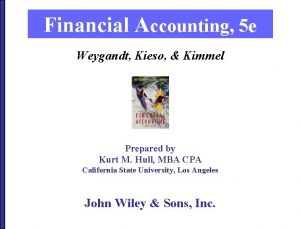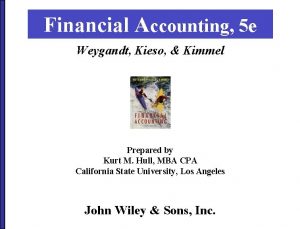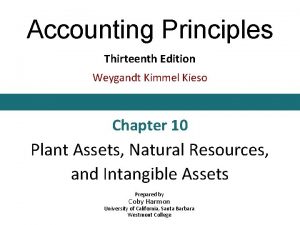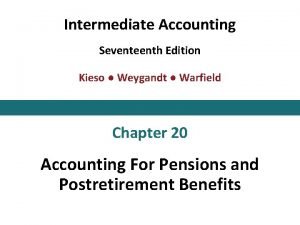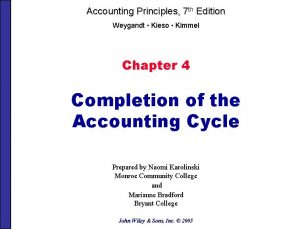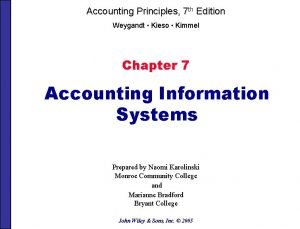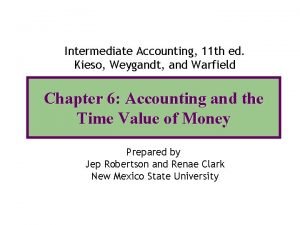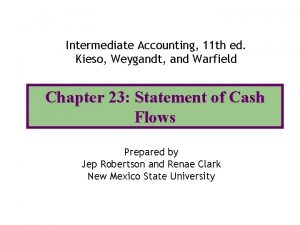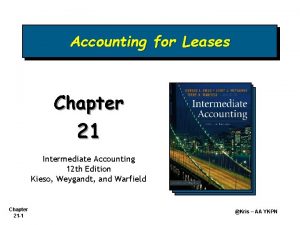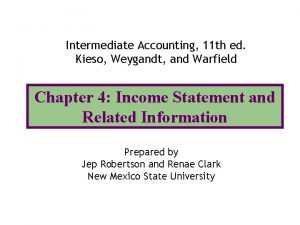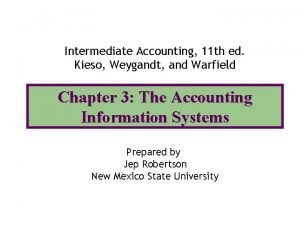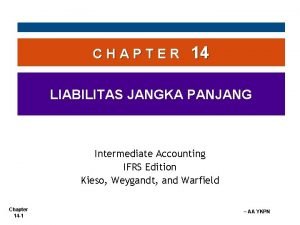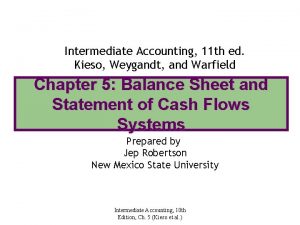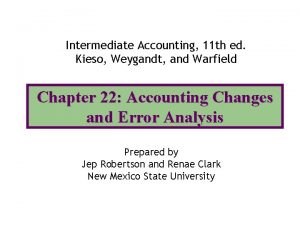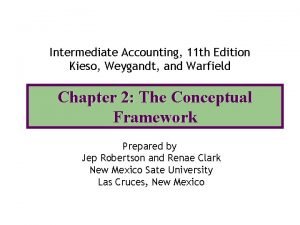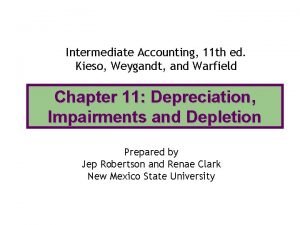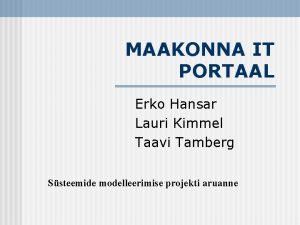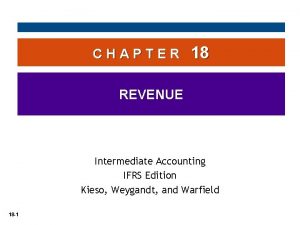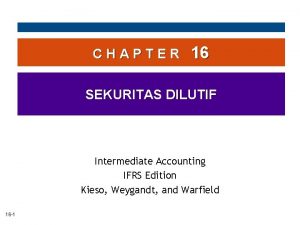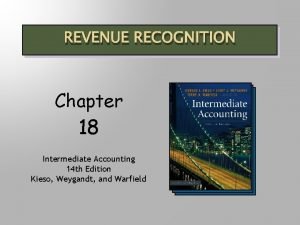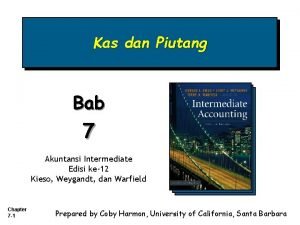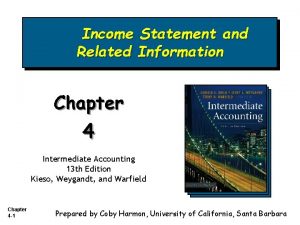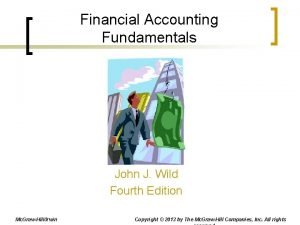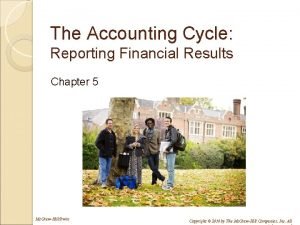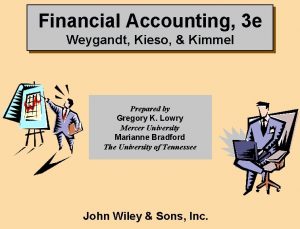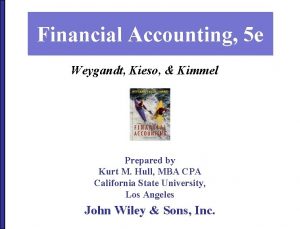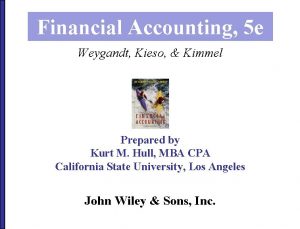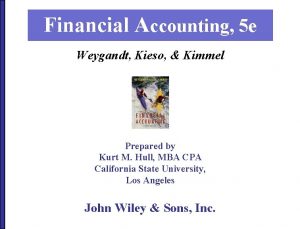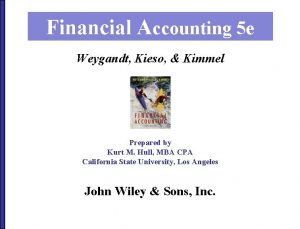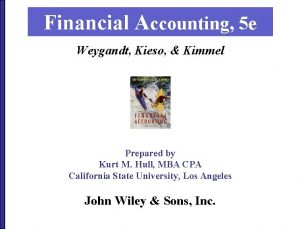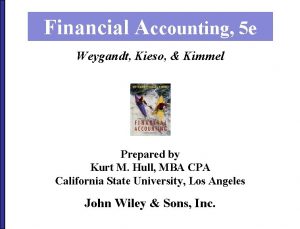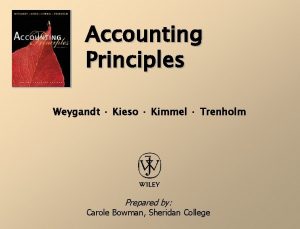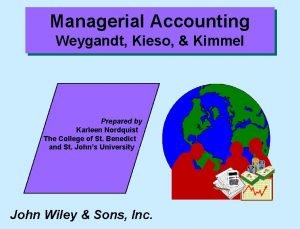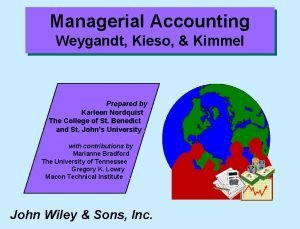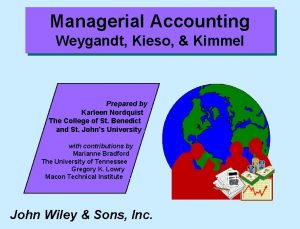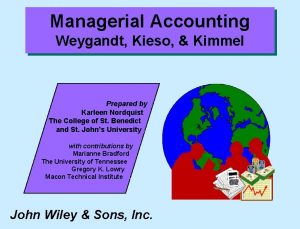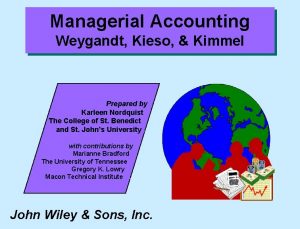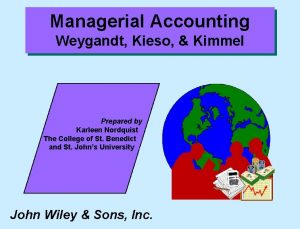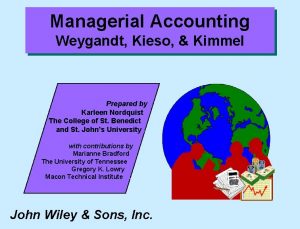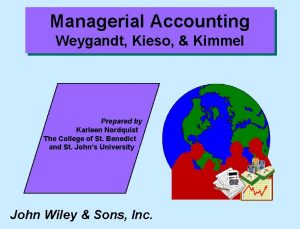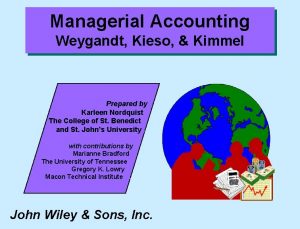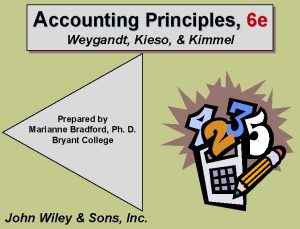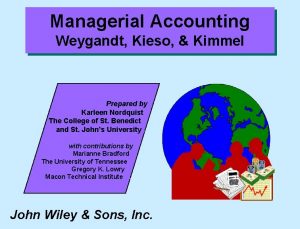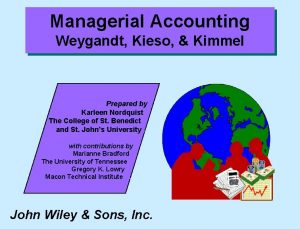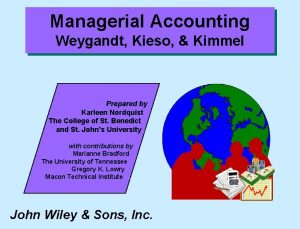Financial Accounting 5 e Weygandt Kieso Kimmel Prepared



































- Slides: 35

Financial Accounting, 5 e Weygandt, Kieso, & Kimmel Prepared by Kurt M. Hull, MBA CPA California State University, Los Angeles John Wiley & Sons, Inc.

CHAPTER 8 INTERNAL CONTROL AND CASH STUDY OBJECTIVES After studying this chapter, you should understand: Definition of internal control Petty cash funds Principles of internal control Control features of a bank account Internal control for cash receipts Bank reconciliations Internal control for cash disbursements Cash reporting

STUDY OBJECTIVE 1 DEFINITION OF INTERNAL CONTROL The plan of organization and all related methods and measures adopted by a business in order to: Safeguard assets Enhance accuracy and reliability of accounting records

STUDY OBJECTIVE 2 PRINCIPLES OF INTERNAL CONTROL Establishment of responsibility Physical, mechanical, & electronic controls Segregation of duties Independent internal verification Documentation procedures Other Controls Illustration 8 -1

ESTABLISHMENT OF RESPONSIBILITY Control is most effective when only one person is responsible for a given task. Only one cashier should operate a cash register during a shift. Cash is reconciled at the beginning and end of the shift.

SEGREGATION OF DUTIES • Related activities should be assigned to different employees – 採購、驗貨、付款 – 銷售、運送、開立帳單 • Record-keeping separate from custody The cashier should not update the accounting records.

DOCUMENTATION PROCEDURES • Documents are pre-numbered (憑證應預先編號) • Sequence is accounted for (憑證應有說明) • Documents are forwarded to accounting department promptly (會計分錄的原始憑證應迅速送至會計部門, 以即時確保記錄交易或事件) Checks have sequential numbers. Missing check numbers are investigated.

PHYSICAL, MECHANICAL, & ELECTRONIC CONTROLS • Designed to safeguard assets and accounting records • Also designed to restrict access Bank vault Locked warehouse Access codes Passwords Alarms Time clocks

INDEPENDENT INTERNAL VERIFICATION • • Review, comparison, & reconciliation of data prepared by another employee On a surprise basis INTERNAL AUDIT By an independent person DEPARTMENT Discrepancies noted and reported Manager compares daily sales summaries with cash register tapes.

OTHER CONTROLS • Bonding employees who handle cash • Rotation of duties • Mandatory vacations make it impossible for a bookkeeper to permanently conceal “irregular” activities.

SEGREGATION OF DUTES VS. INDEPENDENT INTERNAL VERIFICATION Segregation of Duties Assistant Cashier B Maintains custody of cash on hand Accounting Employee A Maintains cash balance per books Independent Internal Verification Assistant Treasurer C Makes monthly comparisons. Reports differences to treasurer.

LIMITATIONS OF INTERNAL CONTROL Cost-Benefit Considerations The cost of implementing a control should be less than the perceived benefit. Human Element A system is only as good as the people operating it. Collusion Two people may conspire to override a control

STUDY OBJECTIVE 3 INTERNAL CONTROL FOR CASH RECEIPTS • Only designated personnel are authorized to handle or have access to cash receipts. • Different individuals should: 1 receive cash 2 record cash receipt transactions 3 have custody of cash

INTERNAL CONTROL FOR CASH RECEIPTS • Register tapes, remittance advices and deposit slips • Cash should be stored in safes and bank vaults • Access to storage areas should be limited to authorized personnel • Cash registers should be used in executing over-the-counter receipts

INTERNAL CONTROL FOR CASH RECEIPTS • Daily cash counts and daily comparisons of total receipts. • All personnel who handle cash receipts are bonded and required to take vacations. • Cash registers are visible to customers.

STUDY OBJECTIVE 4 INTERNAL CONTROL FOR CASH DISBURSEMENTS • • • Limit & specify check-signing authority. Separate approval and payment functions Payments made by pre-numbered check. Pay only approved invoices. Store blank checks in a safe, and limit access. Stamp invoices when paid.

REVIEW QUESTION The use of pre-numbered checks in disbursing cash is an application of what internal control principle? Answer: Documentation procedures

STUDY OBJECTIVE 5 PETTY CASH FUNDS • Used to pay small amounts • An IMPREST SYSTEM involves: • 1 establishing the fund • 2 making payments from the fund • 3 replenishing the fund • Accounting entries are required when: • 1 the fund is established • 2 the fund is replenished • 3 the amount of the fund is changed

ESTABLISHING THE FUND • Two steps to establish a petty cash fund 1 appoint a responsible custodian who will be responsible 2 determine the size of the fund (to cover 3 -4 weeks) 100 The check is written to the custodian.

REPLENISHING THE FUND • Custodian initiates request for reimbursement. • Custodian prepares a schedule of payments with documentation • Treasurer approves replenishment. GENERAL JOURNAL Date Mar. 15 Account Titles and Explanation Postage Expense Freight-out Miscellaneous Expense Cash (To replenish petty cash fund) Debit Credit 44 38 5 87 On March 15 the petty cash custodian requests a check for $87. The fund contains $13 cash and petty cash receipts for postage $44, freight-out $38, and miscellaneous expenses, $5.

REPLENISHING THE FUND Revised entry for cash over and short. GENERAL JOURNAL Date Mar. 15 Account Titles and Explanation Postage Expense Freight-out Miscellaneous Expense Cash Over and Short Cash (To replenish petty cash fund) Debit 44 38 5 1 Credit 88 On March 15 the petty cash custodian requests a check for $88. The fund contains $12 cash and petty cash receipts for postage $44, freight-out $38, and miscellaneous expenses, $5.

STUDY OBJECTIVE 6 CONTROL FEATURES--BANKS Using a bank minimizes currency that must be kept on hand contributes significantly to good internal control over cash. A company can safeguard its cash by using a bank as a depository and as a clearing house.

WRITING CHECKS • • • A written order signed by the depositor directing the bank to pay a specified sum of money to a designated recipient. Three parties to a check are: 1 Maker/drawer issues the check 2 Bank/payer on which check is drawn 3 Payee to whom check is payable

BANK STATEMENTS A bank statement shows: (存戶的往來交易及餘額) 1 checks paid & other debits charged against the account 2 deposits and other credits made to the account 3 account balance after each day’s transactions • • Debit memorandum indicate charges against the depositor’s account. (ATM service charges). Credit memorandum indicate amounts that increase the depositor’s account. (Interest income).

STUDY OBJECTIVE 7 RECONCILING THE BANK ACCOUNT • Reconciliation is necessary because the balance per bank and balance per books are seldom in agreement due to time lags and errors. • Reconciliation should be prepared by an employee who has no other responsibilities pertaining to cash.

RECONCILING THE BANK ACCOUNT • Steps in preparing a bank reconciliation: 1 Determine deposits in transit 2 Determine outstanding checks 3 Note any errors discovered 4 Trace bank memoranda to the records • Each reconciling item used in determining the adjusted cash balance per books should be recorded by the depositor.

BANK RECONCILIATION LAIRD COMPANY Bank Reconciliation April 30, 2006 Cash balance per bank statement Add: Deposits in transit Less: Outstanding checks No. 453 No. 457 No. 460 The bank statement for the Laird Company shows a balance per bank of $15, 907. 45 on April 30, 2002. $ 15, 907. 45 2, 201. 40 18, 108. 85 $ 3, 000. 00 1, 401. 30 1, 502. 70 Adjusted cash balance per bank $ 12, 204. 85 Cash balance per books Add: Collection of $1, 000 note receivable plus interest earned $50, less collection fee $15 Error in recording check 443 Less: NSF check Bank service charge Adjusted cash balance per books 5, 904. 00 On this date the balance of cash per books is $11, 589. 45. $ 11, 589. 45 $ 1, 035. 00 36. 00 425. 60 30. 00 1, 071. 00 12, 660. 45 455. 60 $ 12, 204. 85

ENTRIES FROM THE BANK RECONCILIATION GENERAL JOURNAL Date Apr. 30 Account Titles and Explanation Cash Miscellaneous Expense Notes Receivable Interest Revenue (To record collection of notes receivable by bank) Debit Credit 1035 15 1000 50 Collection of Note Receivable. This entry involves four accounts. Interest of $50 has not been accrued and the collection fee is charged to Miscellaneous Expense.

ENTRIES FROM THE BANK RECONCILIATION GENERAL JOURNAL Date Apr. 30 Account Titles and Explanation Cash Accounts Payable — Andrea Company (To correct error in recording check No. 443) Debit Credit 36 36 Book Error. An examination of the cash disbursements journal shows that check No. 443 was a payment on account to Andrea Company, a supplier. The check, with a correct amount of $1, 226. 00, was recorded at $1, 262. 00.

ENTRIES FROM THE BANK RECONCILIATION GENERAL JOURNAL Date Apr. 30 Account Titles and Explanation Accounts Receivable — J. R. Baron Cash (To record NSF check) Debit Credit 425. 6 NSF Check An NSF check becomes an accounts receivable to the depositor. 425. 6

ENTRIES FROM THE BANK RECONCILIATION GENERAL JOURNAL Date Apr. 30 Account Titles and Explanation Miscellaneous Expense Cash (To record charge for printing company checks) Debit Credit 30 30 Bank Service Charges Check printing charges (DM) and other bank service charges (SC) are debited to Miscellaneous Expense because they are usually nominal in amount.

REVIEW QUESTION Which of the following items requires an adjusting entry by the depositor? 1. Outstanding checks 2. Deposits in transit 3. A bank error 4. Bank service charges Answer: Bank service charges

STUDY OBJECTIVE 8 REPORTING CASH • Cash reported on the Balance Sheet includes: 1 Cash on hand (includes petty cash) 2 Cash in banks • Cash is the most liquid asset • Cash is listed first in the balance sheet. • Cash equivalents are investments with maturities of 3 months or less, such as money market funds, CD’s, and treasury bills and notes.

COPYRIGHT Copyright © 2006 John Wiley & Sons, Inc. All rights reserved. Reproduction or translation of this work beyond that permitted in Section 117 of the 1976 United States Copyright Act without the express written consent of the copyright owner is unlawful. Request for further information should be addressed to the Permissions Department, John Wiley & Sons, Inc. The purchaser may make back-up copies for his/her own use only and not for distribution or resale. The Publisher assumes no responsibility for errors, omissions, or damages, caused by the use of these programs or from the use of the information contained herein.

CHAPTER 8 INTERNAL CONTROL AND CASH
 Kimmel accounting tools 5e
Kimmel accounting tools 5e Financial and managerial accounting weygandt kimmel kieso
Financial and managerial accounting weygandt kimmel kieso Kimmel weygandt kieso accounting 5th edition
Kimmel weygandt kieso accounting 5th edition Kimmel weygandt kieso accounting 5th edition
Kimmel weygandt kieso accounting 5th edition Weygandt kimmel kieso
Weygandt kimmel kieso Kieso weygandt warfield
Kieso weygandt warfield Kimmel financial accounting 7the edition
Kimmel financial accounting 7the edition Financial accounting kimmel ch1-2
Financial accounting kimmel ch1-2 Kimmel financial accounting 7e
Kimmel financial accounting 7e Intermediate accounting kieso
Intermediate accounting kieso Intermediate accounting kieso
Intermediate accounting kieso Chapter 21 accounting for leases kieso terjemahan
Chapter 21 accounting for leases kieso terjemahan Intermediate accounting kieso
Intermediate accounting kieso Intermediate accounting kieso
Intermediate accounting kieso Chapter 14 intermediate accounting kieso bahasa indonesia
Chapter 14 intermediate accounting kieso bahasa indonesia Intermediate accounting
Intermediate accounting Intermediate accounting kieso
Intermediate accounting kieso Chapter 17 intermediate accounting
Chapter 17 intermediate accounting Primary qualities of accounting information
Primary qualities of accounting information Intermediate accounting kieso
Intermediate accounting kieso Limitations of responsibility accounting ppt
Limitations of responsibility accounting ppt Intermediate accounting chapter 1
Intermediate accounting chapter 1 Marie fastabend
Marie fastabend Kimmel magdolna
Kimmel magdolna Lauri kummel
Lauri kummel David kimmel design
David kimmel design Intermediate accounting chapter 18
Intermediate accounting chapter 18 Kieso chapter 16 bahasa indonesia
Kieso chapter 16 bahasa indonesia Intermediate accounting revenue recognition
Intermediate accounting revenue recognition Bab 7 kas dan piutang
Bab 7 kas dan piutang Irregular items on income statement
Irregular items on income statement Non-financial methods of motivation
Non-financial methods of motivation Importance of financial accounting
Importance of financial accounting Financial accounting wild
Financial accounting wild Unit 5 lesson 2 financial accountings
Unit 5 lesson 2 financial accountings Financial accounting chapter 5
Financial accounting chapter 5


